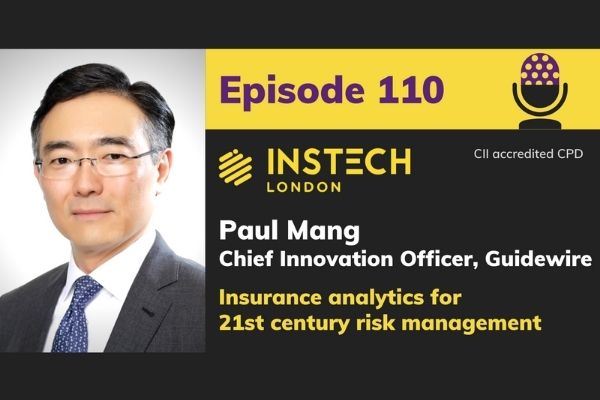Insurance might be “swimming in data” – but without actionable insights that data is just noise.
Matthew catches up with Paul Mang, Chief Innovation Officer at Guidewire to explore the latest developments in innovation, modelling and interpreting data to advance the understanding and management of risk.
Listen now to learn about:
- Parallels between biotechnology and insurance
- Sense-making of data for actionable insights
- The challenges of managing cyber risk
- Innovating through the Guidewire Marketplace
- The hype vs reality of IoT and sensors
If you like what you’re hearing, please leave us a review on whichever platform you use, or contact Matthew Grant on LinkedIn.
Sign up to our newsletter for a fresh view on the world every Wednesday morning.
Insurance analytics for 21st century risk management – Podcast 110 highlights
Matthew: Paul, can you start by breaking down what is the Guidewire Analytics value proposition for clients?
Paul: We have a three-part value proposition. One part is around data and making internal and external data more actionable. The second part is “embedded analytics” to break down the barrier between transaction processing and operations. We have an approach of “sense-making” – using models to interpret very messy data. The third is our data listening engine. As the world changes and becomes more digital, businesses and households throw off a lot of data elements and the data listening engine allows us to look at that. It’s a different way of underwriting and we can address new risks like cyber.
Another part is a commitment from Guidewire to advancing the art of understanding and managing risk. We have an innovation model that includes the Guidewire Marketplace, which allows us to collaborate with interesting start-ups or others in the broader ecosystem, not just for Guidewire but on behalf of our clients. I have a passion for working with entrepreneurs and we’re always open to talking to anyone interested in understanding risk and helping to manage it.
Matthew: Looking at all the companies that you’ve been involved with, what was it that led you towards a career in insurance?
Paul: I was very interested in technology with an engineering background, but also the innovation of businesses using technology. Back in the 70s and 80s, the big new technology was biotechnology and transforming what was then a chemical-based pharmaceutical industry. There are some similarities with insurance; back then, biotechnology threatened to overturn the chemical-based pharmaceutical old guard.
Matthew: Looking back at the promise of biotech then and where it is now, has it delivered on that promise?
Paul: Biotech has had an immense impact on medicine, treatments, vaccines and therapeutics and has delivered in advancing that science. That led to investors coming in and biotechnology was the accelerant for the modern-day venture capital industry because money was being pumped into small entities. The story back then was that this traditional 19th-century industry would fade out, and a new set of companies would come in. It hasn’t developed exactly like that.
There are many parallels with insurance and my excitement about Guidewire’s Marketplace idea is a recognition of that. It isn’t going to be as simple as all the small companies withering away and the large companies doing more incrementally, nor will it be a revolution, but it will be something in between.
Matthew: You mentioned sense-making of data, which is a really interesting concept. When people use the term big data and celebrate all the data that’s out there, that’s good, but it’s at the start of the journey and that data has to provide actionable insights. Can you give us an example of where insurers are cutting through the noise and making sense of the data?
Paul: Sense-making as I described it has more to do with modelling and interpreting data. This industry is essentially swimming in data, with significantly different databases and units around the globe. We need to bring that together as a data engineering task, but even after that, the real challenge is how do we interpret the data so we understand it? Can we model it at scale? At Guidewire, we’ve got an approach to not just modelling and doing it as a one-off, but we have a platform to interpret data and model it at scale. In fact, we’re moving to one that’s more intelligent and it’s more proactive if it does some of the work for us, as a human would do. It just accelerates things.
The best example to point to is in cyber, which is inherently data intensive. It’s about access to data, the control and governance of data, pre-event mitigation and post-event recovery. All of that has a lot of modelling and interpretation involved.
The entrepreneurs who start companies know that having an insight is only half the battle. There are all sorts of implications to just saying something has more risk. Competitive dynamics is not traditionally part of what we think of as sense-making, but it’s an important part of taking action and creating value.
Matthew: There was a widely circulated number that by 2020 there would be $20 billion worth of cyber premiums but in reality, it’s closer to $6 billion. Is cyber not as big of an issue as people originally expected?
Paul: It would be hard for anyone to conclude that cyber risk isn’t really there. Small business owners know that there are things that could lock them out of their systems, and large companies with very complicated supply chains are investing a lot in protecting them.
The real question is, can we as a sector understand it enough to provide risk management? It is hard to do. We don’t have the right historical data about this phenomenon. There’s a sentient adversary that acts very differently than a flood or a windstorm and the scope is broad. It’s surprising that anyone was predicting it would grow that quickly.
We’re just about to release a white paper on the myths of cyber. There are real challenges and they continue to be challenges, but the myth is that we can’t make progress.
Matthew: What are you seeing in intangible risks outside of cyber that Guidewire might be able to help with?
Paul: Insurance only works if an insurer can understand the economic activity that’s creating the exposure and what the volatility is of something of value. Then they need the analytics to apply capital.
If we look at what happened with Covid-19 and business interruption, restaurants needed access to something when nothing got physically damaged, so there is a disconnect. If we can’t address this collectively as a sector, we’ll become a smaller part of society and be less relevant.
Cyber is the tip of the spear and we’ve learned a lot. We’re looking at liability lines and other areas where we could use this behavioural analytic approach. Reputation data and intellectual property are things that give a company access to something to create value, and this is the future of insurance. We will have models for this, and we need to use different modelling techniques to understand how to interpret them. We’re heading in the right direction and putting our investments in the right place.
Matthew: There’s been a lot of discussion about the benefits for insurers from IoT and sensors, but it’s been hard for organisations to put the technology into practice. How can the industry move forward?
Paul: This is a classic case of the promise and the hype outrunning the reality. The early telematics devices that were put into vehicles were very expensive and there are all sorts of concerns about who owns the data. Also, if we look at what could be their real implications, operational data streaming from sensors, that’s not easily consumed by most insurers.
One of the concepts we’re pushing is the idea of continuous digital underwriting. That means instead of underwriting and rating once every six months or 12 months, we as an industry will move to continuous underwriting, which is only possible with this future of sensors.
The starting point is using the data in sensors already on the internet. Search engines are combing through the internet, they’re not putting devices in our PCs or iPhones, but they know a lot about what’s going on in the world. Putting sensors in software and having software code speak to us, having hardware speak to us through proprietary mechanisms, will be the start of the IoT sensor era in insurance.
Matthew: From your experiences in and outside of insurance, what is the balance and likelihood of success of building technology that fits into existing workflows, versus doing something really different?
Paul: We need to provide smarter inputs and insights into the current workflow to help with accelerating and lowering the cost of what we have. In the traditional ‘pave the cowpath’ approach, the path is cobbled together with stone and we could put asphalt on to make it a little better. In parallel, we could put a superhighway right next to it. It’s on a completely different infrastructure. It goes straight, it’s bigger, but the challenge is that it takes a lot of work from many different sources.
That’s what I’m so excited about with the Guidewire Marketplace because it allows almost a crowdsourcing approach to innovation. There are point solutions that can assist in operationalising within the current workflow, or there are new sources to underwrite different business intelligence tools.
One of the major challenges of insurance today is scale. What’s the minimum scale needed for some line to make money? Right now, it’s arguably very high. There are a lot of niche opportunities that incumbent insurers would have to pass up because they don’t reach some minimum scale for a quote. There’s plenty of opportunities for entrepreneurs to invest time, energy and resources in creating solutions that improve the current workflow. I’d be excited to talk to anyone who is thinking about what the superhighway is that brings capital and exposures together in an efficient way.
Matthew: Is there anything we haven’t covered that you’d like to bring to people’s attention?
Paul: One of the things getting us excited at Guidewire, if we look broadly across industries, is this idea of ESG (environmental, social and governance). For investors who have a particular strategy to invest a particular way, there’s a standardised way to understand who’s following certain guidelines. There’s a tonne of demand around that right now. 40% of the earning calls of S&P 500 companies this year have had some discussion about diversity and inclusion. This is one of the elements of ESG.
What can a technology partner for insurance companies do here? It turns out that our Cyence tool helps, among other things, address data hygiene and data governance. Understanding the cyber threat is one of the factors used for understanding ESG standards.
We’re partnering with S&P who’ve come up with an ESG rating system that’s in the market now. This idea of an ESG rating system is fascinating. It’s here and to be relevant in society, we have to develop the tools and understand the data that is relevant for understanding this phenomenon. I’m excited about what we’re doing with carriers and insurers around the world, but also with other entities that are looking at data in this way.
Matthew: Thank you Paul, and for anyone wanting more information about the Guidewire Marketplace, we ran an event talking to your colleague Neil Betteridge which can be reviewed here.
Continuing Professional Development – Learning Objectives
InsTech London is accredited by The Chartered Insurance Institute (CII). By listening to an InsTech London podcast, or reading the accompanying transcript, you can claim up to 0.5 CPD hours towards the CII member CPD scheme.
Complete the InsTech London Podcast Feedback Survey to claim your CPD time.






